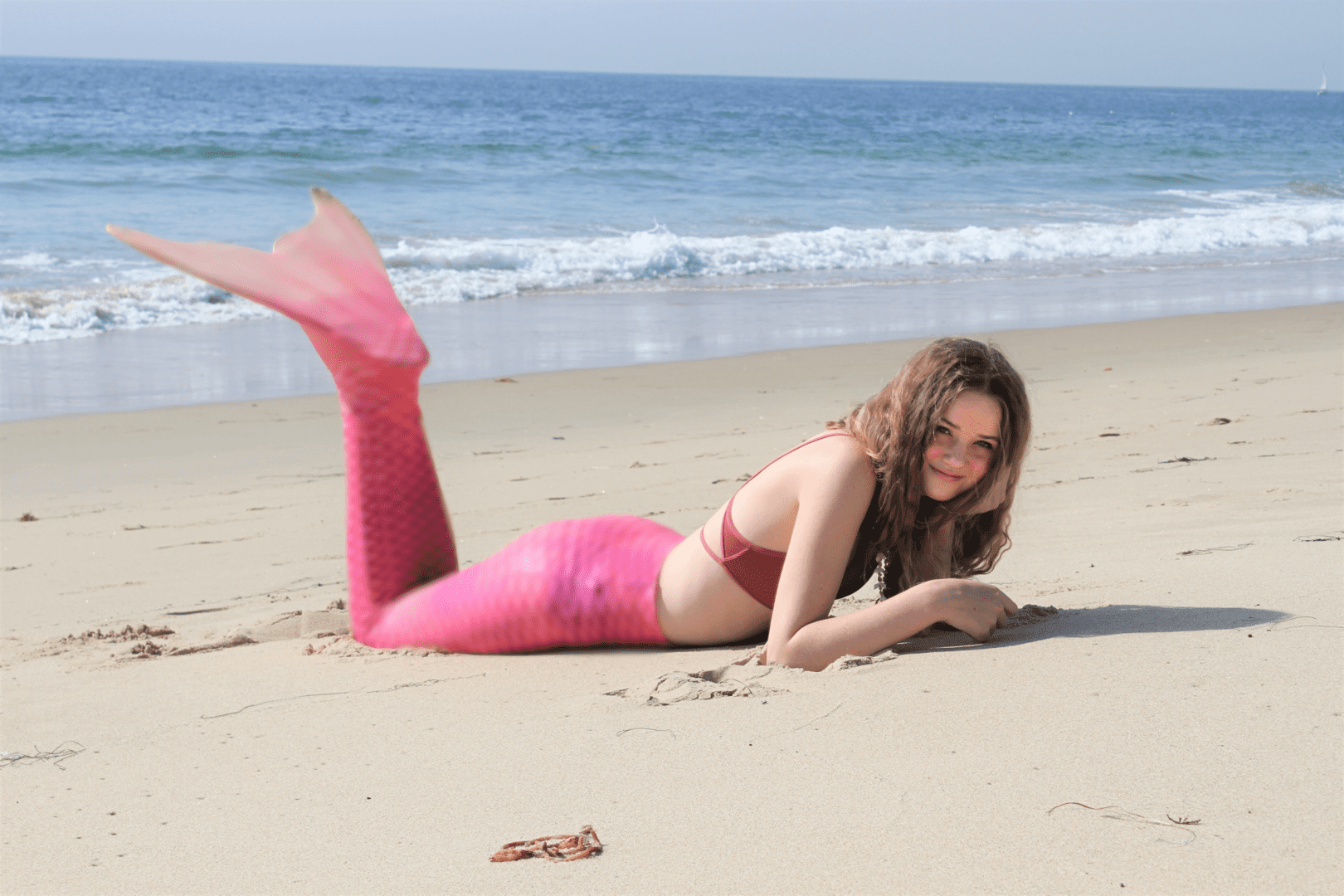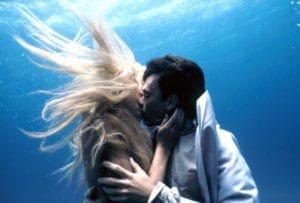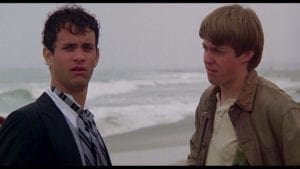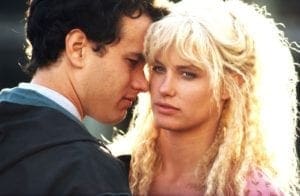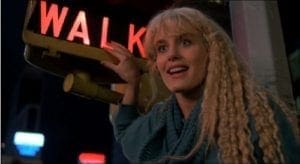Splash
"She was the woman of his dreams... she had large dark eyes, a beautiful smile and a great pair of fins."
(1984)
starring Tom Hanks and Daryl Hannah
PODCAST:
'80s Movies:
A Guide to What's Wrong with Your Parents
OUR TAKE ON SPLASH:
A LOVABLE DISNEY MOVIE WITH CHILD NUDITY, BESTIALITY & A SEX CRIME.
Why it’s rad:
Splash was a fantasy come true – girls dream of being a mermaid, boys dream of having a mermaid girlfriend.
Splash was The Little Mermaid five years before Ariel pined about being "a part of your world."
The film made a star out of Daryl Hannah, but, most importantly, it took an affable, well-liked TV star named Tom Hanks and turned him into a movie star, for which the world will always be grateful.
Why it’s So '80s:
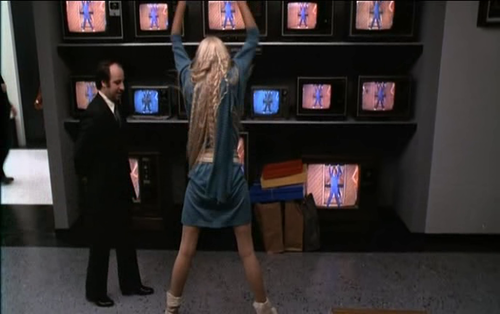
'80s fashion includes Madison's slouchy boots and the Anne Klein ads for Bloomingdale's.
When Madison is learning to speak English in Bloomingdale's electronics department, she watches teeny tiny '80s TV sets and sees classic '80s commercials and does aerobics with '80s icon Richard Simmons to Donna Summer's 1983 hit "She Works Hard for the Money."
Freddie's Trans-Am, the cool sports car of the '80s.
Madison and Allen walk past several cinema marquees promoting films from 1983: Raiders of the Lost Ark, The Outsiders and Lone Wolf McQuade. A poster for Flashdance is in the background at a movie theater. The Evil Dead (1981) is on a different cinema marquee (next to some XXX-rated films of the era).
Allen says he and Madison need a blood test before getting married, something that is no longer necessary.
When Madison tail emerges, paparazzi swarm, with a reporter from People Magazine asking, “Is it true she’s also seeing [iconic '80s sex symbol] Burt Reynolds?”
What’s your damage?

In some ways, Splash can be admired as a film that throws the typical '80s messaging out the window. It's the upside down of rom-coms. (SPOILER next!) Instead of the fair maiden riding off with the handsome prince into the sunset, leaving her home behind to live in his world, Allen gives up everything to follow the woman he loves - Madison guiding him through her world. Additionally, Madison is a woman in charge of her own sexuality with no hang-ups (how nice to grow up in a society that does not body- and slut-shame, even if it is a society of fish people).
Cringeworthy '80s filmmaking moments are present, mostly Freddie. The film opens with 10-year-old Freddie dropping quarters by women's feet so that he can get down on his knees and then look up their skirts. When his mother catches him, she tells her husband so he will discipline him. Freddie's dad just gives him a light smack in the side of the head. Yep, dad, that's the way to handle a sexual predator! Freddie grows up to be a womanizing, cheating lout whose only moral standard seems to be looking out for his brother (including successfully getting a client by telling him Allen is a war hero with a disability). None of Freddie's behavior really matters, he is successful in business and gets the women. Freddie's only consequence, it seems, is that he is unable to keep love - but it's hard to feel sorry for him. This is the guy "brought a date to [his] own wedding."
Freddie aside, the most appalling and '80s moments happened in the making of Splash.
Brian Grazer conceived the idea of what it would be like to fall in love with a mermaid in 1977. He would spend the next seven years pitching it to every studio in town before he realized the reason behind the rejection. Grazer was pitching it too much from the point of view of the mermaid – literally, a fish out of water story, but still, not relatable (READ: to male film studio execs). He adjusted the pitch to focus on the love story – about the MAN who falls in love with a mermaid, shifting the story from her perspective to his. Of course…that was the needed switch.
So, first, let's give credit to Grazer for thinking from the female point of view and being so green that he never dreamed Hollywood was only buying male-driven stories.
Okay, now let's examine how that switch changed the subconscious messaging of the movie. Madison became male fantasy fulfillment:
· She’s physically perfect.
· Unlike Allen’s previous girlfriend, Madison doesn’t need affirmations of love or even conversation – she just wants to get nasty.
· She has no expectations of Allen whatsoever. In fact, when he gives her a gift from Tiffany’s, she’s thrilled with just a box.
· She rejects Allen’s marriage proposal…which means she was just planning to have wild, nonstop sex with him for 8 days and then leave, never to be heard from again – no strings attached.
· Allen blows up and speaks cruelly to Madison. She runs off, but she returns with the answer he wanted to hear. He didn’t have to “pay” for his outburst with a thousand apologies, cold shoulders, or worse – a long conversation.
· When they’re reunited in the lab, Madison tells him he doesn’t have to feel bad about not loving her anymore – no guilt trips.
· Basically, Madison was willing to give everything up for Allen (from her necklace to her family) without ever asking for anything in return.
The other part of the troubling part of Splash is also behind the scenes. Daryl Hannah didn't want to bare her breasts through the film. Ron Howard was bent on having a naked, gorgeous mermaid. He said Hannah talked him out of it, persuading him it would be more sensual if her breasts were not exposed. However, Grazer has said it was the deal with Disney that forced their hand to keep her breasts from being seen. (Details below under "Nudity".)
The more revolting and heartbreaking part is that Howard insisted the 7-year-old model who plays Madison take her top off for filming; Shayla Mackarvich, now an adult, has said that she was adamant about not wanting to be topless. She details how Howard had even enlisted Hannah to talk her into being comfortable with being filmed with no shirt. When it was time, she was made to remove her top, which caused her great emotional distress. When the camera captures her crying because Allen is taken away, she's really crying because she wants her mother to come get her out of the situation.
Behind the Scenes
GETTING THE GREENLIGHT
The inception of Splash begins as a humiliating meeting between producer Brian Grazer and iconic studio head Lew Wasserman. At the time, Grazer was a recent USC grad who had more or less conned his way into a job as a law clerk for Warner Brothers. He used his studio title to get meetings with people, with a goal of meeting a new person every two weeks – this is how he’d met Ron Howard, by calling down to him from his office when Howard was on the WB lot, and then going downstairs to meet him. Using this strategy, Grazer had succeeded in getting an appointment with Wasserman and then unexpectedly encountered him in the elevator on the way up to the executive's office. Grazer put on his usual charm and tried to get the conversation going. Wasserman shut Grazer down, declaring, ‘You don’t have much to say.” Grazer said Wasserman basically kicked him out, but first handed Grazer a notepad and a pencil. “He says, ‘Put the pencil to the paper, and it’s worth more than it is at separate parts...Okay, now get out of here!'” said Grazer, who added that he realized, “What he meant was you have to own your own ideas.” Thus, Grazer said, “[Splash] was birthed out of that moment that I had with Lew Wasserman kicking me out of his office!”
The specific idea of Splash came to 25-year-old Brian Grazer when he was driving along Pacific Coast Highway near Malibu – a stretch that is pure ocean view – and reflecting on the day he'd had before, the day he met his wife: ''I saw this great girl in a bathing suit running down the beach and we stayed up all night and drank champagne. For the first time in my life, I realized you can have true love. And I thought, 'What if a guy meets a mermaid and has to give up everything to get her?'''
He would then pitch that idea to studios for the next seven years. Most studios rejected it, thinking it too silly. Grazer said, “I probably had 500 turndowns. I’d have turndown after turndown, and then people would say, “You just pitched this,” or, “You just submitted it, but now it’s from the guy’s perspective.” Or now I have this, or I just got John Candy, and some people would say, “Who cares,” some people would say, “Great, now who’s going to be the lead?”
Finally, United Artists was in and funded development. “I wrote the first couple of drafts of the movie Splash, but it actually got really good when Lowell Ganz and Babaloo Mandel wrote it like professional writers,” Grazer told The Hollywood Reporter in 2016. “I was just writing something to survive, so that I could say, “Hey, I have a script,” and then tell the entire story. And then somebody would say, “Let me read it,” and I’d say, “Oh, you don’t need to read it. What I’m telling you is what it is.”
With the funding from UA, Bruce Jay Davidson (Stir Crazy, Doctor Detroit) was hired to write the script. By 1980, Stan Dragoti (Mr. Mom) was signed to direct.
It turned out that Splash was the little mermaid in the big ocean – there was a great white nearby eating up the interest: Mermaid, a $30 million (read: big budget for 1984) film with commitments from a host of heavyweights: Warren Beatty as star, Robert Towne (Chinatown) as writer, Herbert Ross (Footloose, The Goodbye Girl) as director, Ray Stark (Funny Girl, Annie) as producer, and Carlos Rambaldi as mechanical designer (he created the actual E.T.!) Jessica Lange was in talks to play the mermaid, but the 1981 writer’s strike loomed ahead. “It was its own little David and Goliath story,” said Grazer. “I was very resourceful, kind of crazy, and connected to some source that made me believe in what I was doing greater than what they were doing.”
Grazer zoomed in to hire Alan Mandel (Smokey and the Bandit) to do a rewrite, but he didn’t care for it. United Artists was ready to go with Mandel’s script, but Grazer preferred the Friedman script so UA – and Dragoti - let the project go.
Starting over, Grazer looked to his the team that made his prior (and first ever) film, Night Shift, successful. He teamed up with Ron Howard – also just building a name for himself in the directorial world – and they took the project back to Night Shift production company, Ladd Company. Still trying to compete with the behemoth Mermaid project, Grazer and Howard brought back the writers from Night Shift, Babaloo Mandell and Lowell Ganz, to rewrite the Friedman script. Then, Ladd Company passed. Disney was looking to get away from simply being kids stuff to creating more adult fare – Splash was a great first entry. The Touchstone label is specifically for Disney movies with more mature content (such as Something Wicked This Way Comes). ICM agent Jeff Berg connected the two and made the deal for Splash to be made for Touchstone.
In the end, Mermaid never surfaced. Robert Towne was hired to do the rewrite (in which the Oscar winner was paid half a million dollars) in April 1983 – one week before Splash started principal photography. Howard said, “Beatty and those guys didn’t build their careers by racing to beat strike deadlines…We, on the other hand, were happy to win a footrace.”
The thing is, though, that after they finally got the greenlight from Disney – who decided they didn't care about the other mermaid movie – Ron Howard quit. He believed Disney would force him to make a family film instead of his naked sex-crazy mermaid love story. Grazer said, “I had to appeal to the Board at Disney to say, ‘You can’t recut Ron Howard’s movie or he won’t make the movie, he’ll quit as he said. I know you have a thing about the nipples, but I’ll cover up the nipples up. She just can’t wear a bathing suit top! Eventually, the movie got made, and I made it faster than Ray Stark – thank God! - and it gave birth to my career, Ron Howard’s career, Tom Hanks and certainly Daryl Hannah's.”
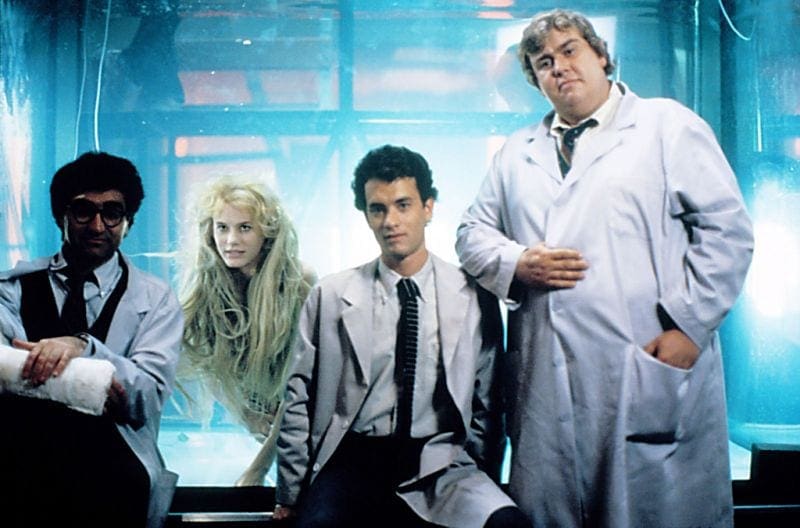
CASTING
In an interview for Buzzfeed, Tom Hanks and Steven Spielberg met and discussed their favorite projects. Hanks gave quite a bit of insight into how he made the unlikely leap from star of a canceled two-season sitcom to leading man: "I had done a TV series for two years and then it got canceled. And then I did nothing for a year. I think I tried to do something for CBS? Anyway, I was invited to be a guest star on "Happy Days" because "Bosom Buddies" shot on the Paramount lot and "Happy Days" and the other Paramount shows would go off on these star-studded celebrity softball games that would raise money for charity, and I did a couple of those so they knew me. And they had some role on "Happy Days" and I went down and did that — it was just a one-shot thing. But Ron Howard had left "Happy Days" the year before because he wanted to go off and direct films. And the guys who were the head writers of "Happy Days," Lowell Ganz and Babaloo Mandel, they wrote Splash.
"Splash was Ron and Brian Grazer's second film, and it was this low-budget movie that was shooting on Disney. And at that time, the Disney studios were kind of like this B enterprise. No one was really doing any work over there. Walt Disney was long dead and they were doing things like Gus, the field goal–kicking mule, and The Boatniks and stuff like that. So they had this other role and Lowell and Babaloo said, 'You should take a look at this guy who came in and did this one episode for us. He was pretty funny, had a lot of energy.' So I went in, and first I met Brian. It was the first time I met guys who were kind of my own age. They were producers and filmmakers, but they weren't, like, 10 years older than me or real established rich guys or anything like that. They were just guys! And I was excited to meet Ron, of course, because I grew up watching him and he was in American Graffiti and all that. And Ron was very insistent on doing a tape test of me right there in a small room at Disney with furniture that had been around since Old Yeller days. They actually had a poster for Old Yeller up on the wall. And so I did that, and up until that point, the closest I'd ever come to any real job was as the goofy sidekick in any movie...all I had was kind of like comedy chops. So I thought I was auditioning for the part that John Candy eventually played.
"And Ron was directing me in the test and the test scenes were for the guy I ended up playing, the lead. So [laughs] I went home and later that day, Ron called. [imitates Howard's voice] 'Hey, hey. It's Ron. I want you to come in. I want you to do a real test that's a little bit more organized. We're going to send the scenes over, but I want you to test for the main guy.' And I was crazed because that had never happened before. So I prepared, went back maybe two days later, and then he called another day later at my house and said, [imitates Howard again] 'Hey, Tom. Ron Howard. Um, listen, you got the part, but here's the thing…' So he said that to me off the cuff and then kept going. The thing was he was really concerned because he really wanted Daryl Hannah and he was getting pushback from the studio. They wanted somebody cuter or something like that. And he wanted to do a full-on, full-wit film camera test and he wanted me to come in and work with Daryl and him. And I said, 'Look, I have to ask you this question: Is it possible for me to blow this job by doing this camera test with Daryl?'
“Am I gonna be so bad in this thing that they're going to go, ‘Well, she's fine. But that guy's gotta go.’ And he said, 'No, don't worry about that 'cause you're hardly going to be on camera.' So it was like the back of my head and stuff like that...
"We had a read-through of it and I was very nervous. I was trying to score with all my lines and trying to get a big reaction or a laugh because that's all I had done on TV is sell a script on Mondays and shoot it on Thursdays. And afterwards, Ron took me to the side and he said, 'I know what you're doing. You're trying to get laughs, but your job is not to get laughs. Your job is to love that girl.' So I thought, Oh my god, one day in and I'm already getting a stern talking-to from the boss. I'm doomed with this thing. But that movie turned out good! You know, some of the critics said, 'Oh, this is just a low-budget E.T.'
"Because, you know, she's from another world, she learned how to speak English by watching TV, she did goofy things with food. In the MAD magazine parody of Splash, the last panel is E.T...Saying something like, [affects Southern accent] “Well, I've seen this before,” or something like that.
Before Tom Hanks, ofers to play Allen Bauer were extended to the hottest stars of the moment: John Travolta (with Saturday Night Fever, Grease, Urban Cowboy and Staying Alive), Chevy Chase (Caddyshack, Foul Play, Vacation), and Bill Murray (Caddyshack, Stripes, Tootsie). Steve Guttenberg auditioned (his agent told him he DIDN’T get the part at the same moment he learned he was being screen tested for Police Academy).
Moreover, Howard didn’t think Hanks “had a chance in hell” in getting the role. He felt that Hanks, then a sitcom star, wouldn’t be appealing enough to the studio heads. In fact, Howard hadn’t even considered him until his assistant made the suggestion.
Splash was only the third film Ron Howard had directed, after Grand Theft Auto and Night Shift. However, it set up some long-lasting relationships. The reteaming between Howard and Grazer resulted in the duo forming Imagine Entertainment and became a producing powerhouse. Also, it marks the first time Howard directed Tom Hanks; the two would go on to make five films together (so far).
Tom Hanks originally auditioned for the role of Freddie Bauer, Allan’s obnoxious, womanizing brother – that role, instead, went to John Candy. Michael Keaton, who was the lead in the Grazer-Howard film Night Shift, was offered a role as well, although he can no longer remember if it was the part of Allen or brother Freddie (admit it, you can see him playing either one, right?). Keaton told Grantland’s Dinner with Daniel, “I really can’t remember now whether it was Tom or John’s role. I just remember at the time thinking I wanted to get away from what I’d just done on Night Shift. I thought if I do it again, I might get myself stuck. So then Mr. Mom came along. (And that was John Hughes, by the way — people don’t know that he wrote that.) So I said no [to Splash] so I could set up this framework right away where I could do different things.”
John Candy told movie critic legend Gene Siskel why he believes he got the role of Freddie: “That deal was due in large part to Tom Wilhite, who was then the production chief at Disney....He really saw something in me and actually gave me a deal to write three pictures for them.''
The character of Freddie is somewhat based on Grazer’s grandmother (we'll assume not the dishonest, womanizing part). Grazer told The Hollywood Reporter, “I had this tiny little Jewish grandmother about this tall and she had all these “isms.” Like “Thing big, be big”; that’s all she’d say, “Think big, be big.” Or she’d say, “Just as easy to love a rich girl as a poor girl.” She had all these Jewish isms. And they were funny to me. “You’re going to be big, you’re going to be special.” All this kind of stuff. All that Friars Club kind of talk. So it was a little woman that was saying this to me. When I had a chance to create a really irreverent character or be part of a really irreverent character in John Candy, I thought I’d give him all those isms of the grandmother. My grandmother would also be the kind of person that would, in fact, drink a beer and play sports.”
Hannah had “dreamed of playing a mermaid.” At the time she was cast in Splash, she was developing a live-action version of the Hans Christian Anderson fable, "The Little Mermaid."
When auditioning for the part, Hannah told Howard she used to swim in her family pool by tying her feet together, swimming with fins and making mermaid sounds. Howard didn't believe her, but it was true.
The kids who played a young Madison and a young Alan were from Miami. Shayla MacKarvich and David Kreps were child models, Kreps’ mother was a stylist and often accompanied her to shoots, so both were comfortable on set. It was, however, their first film. MacKarvich and Kreps both believe they got their roles because of their ability to swim.
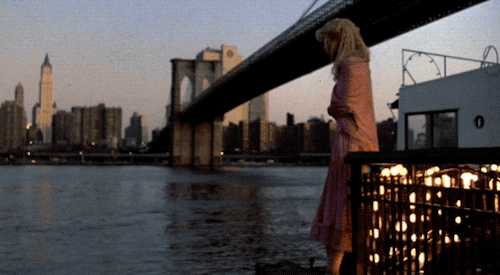
LOCATIONS
Splash is known as a love letter to New York City. Scenes take place at the Statue of Liberty, Times Square, Rockefeller Center, the Hudson River by the Brooklyn Bridge, Bloomingdale's, and of course, our mermaid taking the name "Madison" after the famed Madison Avenue.
Madison starts as a literal fish out of water, using her newfound legs at the Statue of Liberty, for which they closed all of Liberty Island.
The chase scene is in Columbus Circle, where they closed off the street during morning hours.
The authenticity of capturing New York in the '80s is most evident as Madison approaches Bloomingdale's. Brian Grazer explained, “Those people aren’t extras at all. The shot where you see Daryl Hannah entering Bloomingdales and you hear the driving [music that messages] 'this is New York City’. They did not know they were on camera because the shot was so wide, and you don’t see their faces."
The production had an unpleasant surprise and a new headache when they arrived in New York: Rockefeller Center's ice skating rink was closed for renovations. Brian Grazer said, “Our biggest hassle was this ice skating rink because it was so important to the story. We wanted to create romance and we just didn’t see that roller skating or anything could substitute for the feeling of ice skating, and the romance that comes from that. We wanted to use Rockefeller Center, we planned, we talked to these people and everything, and we completely came in on a certain date so we could use at Rockefeller Center. What ended up happening is that they tore it down by the time we got here, so we were in trouble, and we had to build an ice skating rink.”
In fact, when crew members were told Rockefeller Center was no longer available, it was only one week before the scheduled shoot date. Art director Jack T. Collis told Starfix Magazine how he recreated the famed outdoor rink, “We chose a roundabout on Fifth Avenue that allowed light to have interesting perspectives (the scene was a night scene). We started by leveling the ground. Then I installed metal barriers to delineate the ice. Finally, we froze the track with an ice machine. Unfortunately, after forty-eight hours, the weather became too hot for the machine to produce ice, so it was necessary to use a special kind of plastic used in some nightclubs. Despite these difficulties, I think the scene of the rink is technically very successful."
That roundabout was situated across from FAO Schwarz – the same place Hanks would dance on a giant piano mat in Big just four years later.
Returning to New York was special for Hanks. "I lived there a few months when I started, completely broke. And it was for me as a contrast to return there with a leading role," he said. "It is a beautiful thing to shoot outside at night in this city. I have also witnessed an amazing sight: the police themselves blocked traffic in Times Square, and they allowed us to shoot the scene where we are pursued by the army. In the final sequence, the two helicopters that we used (one with actors and the other with cameraman), resembled real helicopters so much that the police services working for President Reagan, who was visiting New York, gave the alarm, thinking they were terrorists! Upon landing, the team were met by FBI agents.... But it all came together when the name 'Disney' was mentioned."
New York isn't the only city where Splash filmed.
The American Natural History Museum was used for exterior shots of the laboratory, but inside, it was a set on the Disney lot.
The Bauer brothers offices were actually a real office at a real produce market in Los Angeles. The office went through a makeover for the film. Because of the business of the produce market, the film had to be shot during off-peak hours.
They water and island scenes are not in Cape Cod, but in the Bahamas. According to Hannah, the water scenes were specifically shot in the Bermuda Triangle. She said a shark was in the area one time during shooting.

THE MAKING OF
Producer Brian Grazer spent four years studying the best way to shoot underwater sequences. According to Grazer, filming underwater is extremely slow. Besides the difficulty in communication, he said the actors are doing buddy breathing, which is swimming from respirator to respirator so they can take breaths. Additionally, the only underwater lighting comes from the sun, which he said is only bright enough between 10a-3pm.
Ron Howard was terrified of the ocean depths, telling People Magazine, “It always scared me.” With Splash, he had to train himself to direct while 30 feet underwater.
Splash shared a cinematographer with Flashdance, Don Petersen. He says you can see some of his hallmarks in both films: the smoke and the soft lighting. He said, “I used soft frontal lighting. It is a light that I use quite often in principle, but in Splash, it allowed to maintain a romantic atmosphere around Daryl Hannah, to make everything, even the city of New York, attractive. We avoided using conventional lighting normally for comedies, where the scenes are steeped in a bright and uniform light.
Jordan Klein, the underwater director of photography, also worked on "Flipper."
The galleon was made out of plastic by Disney Studios and then transported to Florida in two halves, then assembled in the Bahamas. Splash’s galleon is still at the bottom of the ocean.
Hanks and Hannah had to learn to scuba dive. “Up to that point, scuba diving for me was like rock climbing or hang gliding, something you watch on "American Sportsman" on a bad Sunday afternoon,” Hanks said. He told daytime TV talk show host Merv Griffin he became a certified diver, but “now I have $8,000 worth of unusable scuba diving equipment in my garage.”
Stunt divers would place weights in Hanks pants so he wouldn’t float up. He told Griffin that when they’d take a break, the crew would swim up to the top. Hanks – with the weights in his pocket – would slowly, slowly make his way up.
Unlike the divers wearing flippers and Hannah wearing the fish tail, Hanks had to “walk along the bottom of the ocean, jumping from coral head to coral head, looking out for sea urchins that sting down there, which is always gangs of fun. So, I had red marks all over my ankles.”
For the final scene where the actors are gliding along the bottom of the ocean, Hanks said he and Hannah wear their masks down to the bottom so they “could see where the bottom of the ocean was,” but then they’d have to remove them. “We’re blind. You couldn’t see [in front of you].” He said first, they’d have to rub the mask marks off their face, then he and Hannah would look at each other to figure out what they were going to do, and then they’d get the hand gesture that they were rolling.
Hannah’s take on Madison may be the secret sauce to the film working. For instance, her choices are what make the film seem so family-oriented (think about it, you’ve got Freddie handing out Penthouse to his employees and making crude sexual innuedos AND Allen and Madison having nonstop sex). Hannah told Starlog: “Someone else could interpret the character a different way. For example, I could have played Madison as a seductress rather than an innocent and Splash would have been a completely different movie.”
Hannah is a lifelong vegetarian. The crew had to clean out the lobster and fill it with vegan contents. Additionally, she reportedly cried for the dead lobster in between shots.
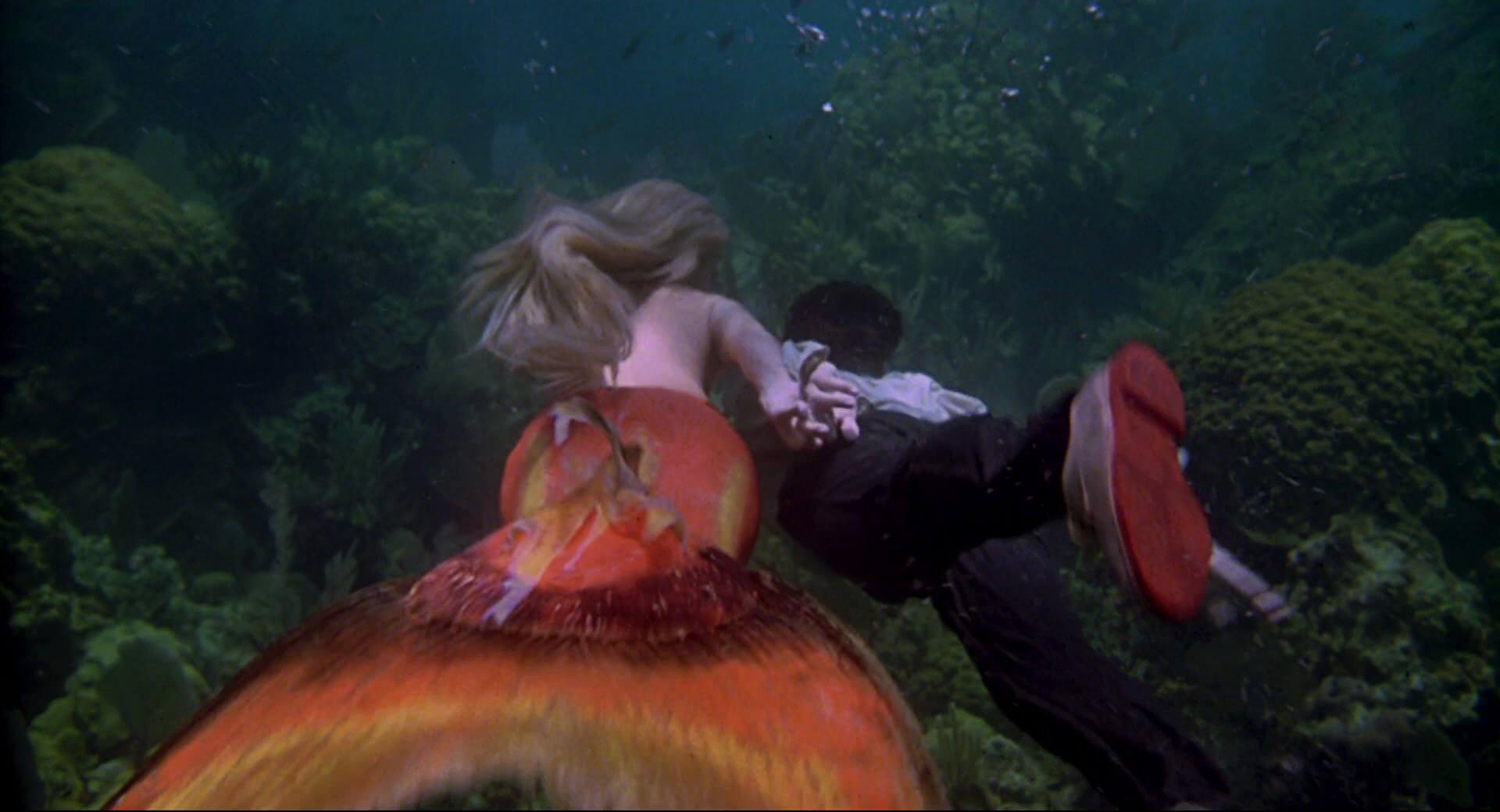
THE TAIL AND UNDERWATER FILMING
The mermaid tail was quite an appendage. It required five to eight hours in the makeup chair for Hannah. The tail consisted of layers of thin latex and the skin and gills had to be painted by hand. Every day was a new experiment in getting it right. There were three versions, the first one cut off Hannah’s circulation and nerves. Hannah told Empire Online that the goal was to make it look like there wasn’t a starting point between skin and tail, but at the same time, it had to be heavy enough so she wouldn’t float up to the top of the water but light enough that she could move and not sink to the bottom of the tank.
Since taking the tail off was time-consuming, Hannah understood not to use the bathroom once she was in it. "If I had to pee, that would ruin the entire day's shoot because it took so long to put on and take off," she said. "My circulation would be gone in my extremities, so it took a while before I could walk again.”
The tail made it hard for her to move around, so once it was on, she was also somewhat stuck. Tom Hanks would come and give her snacks during the breaks. Hannah said she preferred to just be left in the tank. “I'd prefer to be left in the water or in the tank. When I was out of the water it was very painful for me, and I was helpless because I couldn't move. I was like a beached dolphin, laying there wherever the crane placed me on the dock or on a stretcher. I was at the mercy of everybody.
“The hard part about it was being on land. That’s a bad feeling, to just to be lying there, and everybody has to get you a towel for you, if that’s what you want. Or, they have to turn you over, you can’t really flop over with a 35-pound tail,” she said. “That was hard, being lifted in and out of water by this crane.”
Underwater director of photography Jordan Klein said that tail was trouble for everyone: “There were a lot of problems [with the tail] when I came on production. Not only must the crew find a material that is resistant to water, but it also needs to be buoyant. We had to especially camouflage the tail line at the abdomen. To address this last point it took special adhesives and makeup that nevertheless did not take more than two to three hours. The tail was detached or torn; a real disaster. We could make a movie about our troubles with this appendage!”
Tom Hanks told "Entertainment Tonight," “Darryl and I would be underwater with our little masks on and breathing through our little regulators that were attached to air tanks that someone else was holding. When the time came for the cameras to roll, we’d get the signal, (hand gesture) okay, we’re rolling, go! Masks would come off, you’d inhale you’d let the regulator go, and you swim by and do the shot, you wait around 'til you’re all done and they come and pop that air back into your mouth. You’re blind, you can’t see anything because you don’t have a mask on. It was fun and we got til it was like clockwork….
“The closest moments we had were when you were thinking, ‘Am I actually going to make it to the other side of the camera frame in order to get that regulator into my mouth? We always found a way, more than anything else," Hanks continued. "It’s hard to swim in shoes and a suit. I assume it was hard for Darryl Hannah to swim in a prosthetic device. You just eventually learned its just as dangerous as walking across the street because everyone was doing their job. It was fun!"
Hannah told Entertainment Tonight, “It wasn’t hard to swim with [the tail] on because it was hydrodynamically designed.” She said it was created with the intention was for it to look like a fish and, as a result, she “swam faster than the frogmen.” (Frogmen were the safety divers who had held her oxygen.)
In addition to barely being dressed and immobility, Hannah was often, well, as cold as a fish. “We were shooting 40 feet under water and the temperature down there was cold.”
At times, Hannah frequently had to hold her breath for two minutes. “It’s not tough if you don’t worry that you can’t get another breath. If you’re confident you’re going to be able to breathe again,” she said.
Although, there were times when the air wasn’t coming to the actors fast enough. Howard said there were always two safety divers per actor, but sometimes the actors would get away from their safety companion or the diver would get confused if it was okay to come in with the air because the camera was rolling. Occasionally, he said he had to do some buddy breathing, which is sharing his own tank of air.
Underwater kissing is more complicated than it looks. Hannah said there’s an oxygen calculation that comes into play and you have to beware of bubbles coming out from your nose. “The hardest thing to do is kiss underwater – it’s impossible!” she said. “Basically, Tom and I would just put our faces together.”
Originally, when Madison was in mermaid form, she would swim “like a rocket,” said Howard. But, he said “Even when we tried to pull it with a cable, Daryl Hannah was not fast enough and the effect, anyway, was not pretty. We then thought to use animation techniques. But when we realized that Daryl Hannah was an excellent swimmer and she managed to move "naturally" with her tail, we realized that it would be a mistake to introduce these special effects.”
Hannah did her own stunts except for diving into the East River. It was so polluted that the insurance company wouldn’t cover the actress. According to moviesplash.com, the stunt double had to get tetanus shots in case she accidentally consumed some of the dirty water.
Hannah grew to have a mutual affinity with fish. She said the fish seemed to befriend her and “the tail was so convincing I actually had my own pilot fish.” Additionally, “I remember when I was filming the scene in the lab tank I was very upset about a big fish that was being kept in a smaller tank."
Honestly, it seems like maybe Hannah is part fish! Jordan Klein, the Underwater DP, said, “Curiously, with only two weeks to drive in a pool in Los Angeles and four days sea training, Daryl managed to do as well and sometimes better than a stunt person. After a moment, I could even get her to do things I would not dare ask an experienced person. Do not forget she swam fifteen meters deep without breathing apparatus, half her body in this mermaid tail. In addition, moving without a mask, she does not see where she was going.”
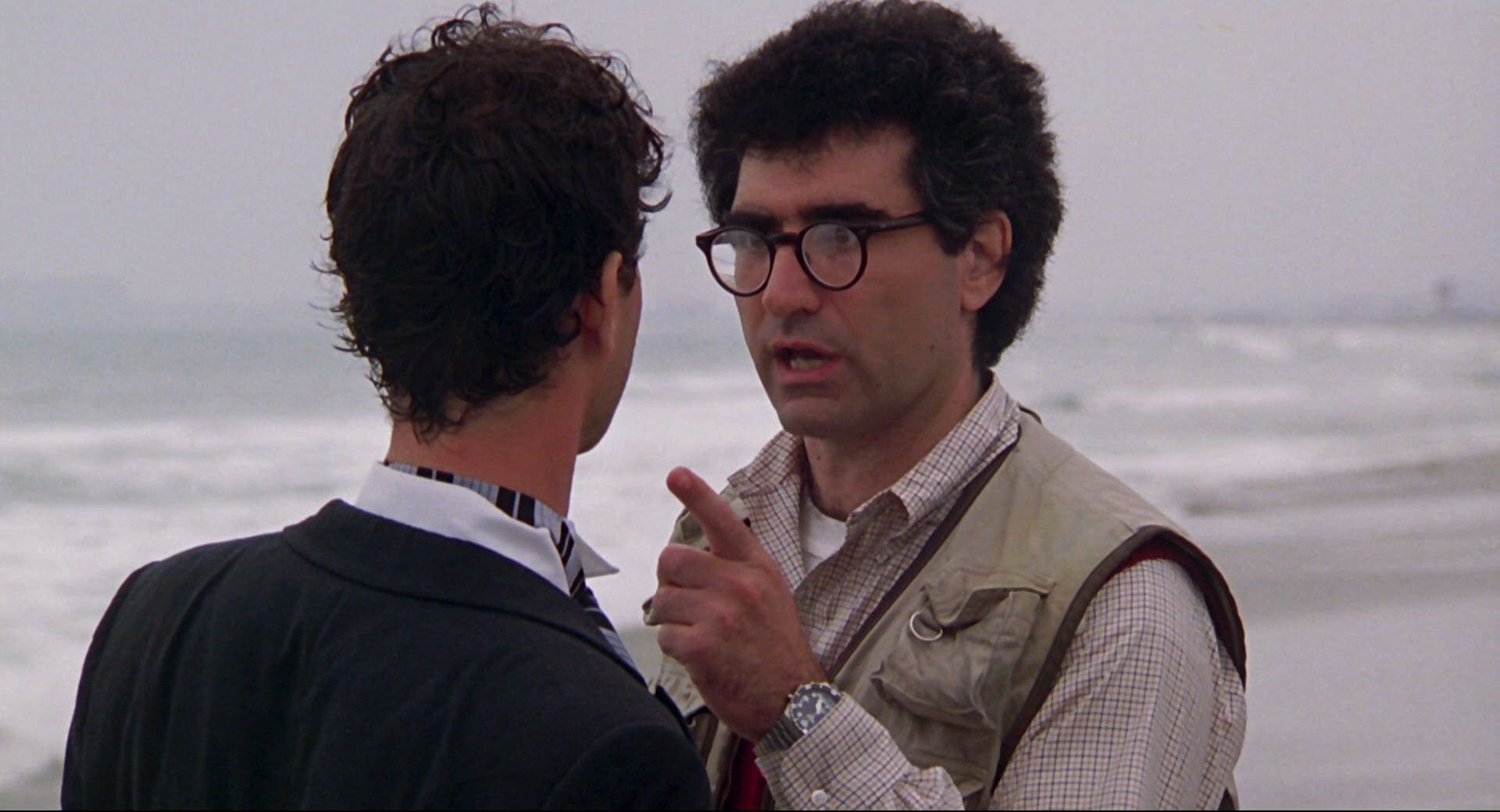
SCRIPT CHANGES
In the first draft, according to MovieSplash.com, Madison and Allen get their blood tests and the results help to explain if Allen actually turns into a merman.
The first draft switches how Allen meets Madison, eliminating the whole sequence where he falls off the motorboat in Cape Cod. Instead, following the wedding scene and Allen's emotional breakdown in the bar, his brother Freddie sends him on a cruise to a luxury resort for some necessary rest and relaxation. On the ship, Allen encounters Dr. Kornbluth and his crates; Kornbluth believes Allen is spying on him. “Dave Boone,” a middle-aged man on the boat, wants to set Allen up with his daughter. Later, at the resort, Kornbluth is setting up on the shore and, again, thinks Allen is spying on him. Allen – trying to escape Dave who is pestering him to meet his daughter – takes a motorboat ride with a drunken man, Stu (instead of Fat Jack). From here, it continues on as it is in the film.
The original script also shows Madison in her mer-community, including that she was a teacher to the mer-children. According to TheMovieSplash.com, “Madison is summoned to a tribunal held by a cast of ‘mer-elders’ who warn her of the dangers of leaving her underwater home to find love/Allen. She is told by an elder of how they were separated from humans millions of years ago. In an oft-discussed plot point, the script reveals that Allen would indeed turn into a merman should he leave New York for the underwater city; in a piece of dialogue (subtitled), an elder tells her that if she chases Allen that she will have the ‘rest of the moon’ to go and find him but would then have to choose: “'Either you become one of them, or he becomes ones of us.’"
Other beats that were dropped include a dressing-room makeover montage scene at Bloomingdale's showing Madison in multiple outfits and more moments of Allen showing Madison the wonders of New York City – going to a concert and a helicopter ride – all with cats constantly following her.

“The fact of the matter is, mermaids are topless," Ron Howard said in an interview promoting the release of the film. "What we needed to do was create an atmosphere and a kind of innocence, so that the nudity in our film was [tasteful]. Once we determined that, then Darryl, being as professional as she could be, did it and we moved on,” said Howard.
Hannah didn’t want to do the nudity, even though she had appeared in Reckless. (In 1982’s Summer Lovers, a body double was subbed in to appear as Hannah). Ron Howard told People Magazine, “She was extremely uncomfortable and determined to put an end to it.”
Howard said, “We had originally envisioned more nudity. When we cast Darryl, she said, ‘I’m really uncomfortable with this, Ron,” and we started to talk about it and agreed to pare it down. One of the things I discovered, that we talked about that Darryl actually said is, ‘You know, it’s going to be a lot more sensual and sexual when you see a little bit less.’ The way we wound up photographing it, I think she was absolutely right, and I learned something as a filmmaker because of her input into this. I think in a lot of ways it is a little bit hotter than blatant nudity.”
Howard doesn't mention that Disney had raised concerns with the nudity as well, at least according to producer Brian Grazer. For cover, Hannah wore a body stocking, Band-Aids over her nipples and makeup over her breasts.
Hannah wasn’t the only actress uncomfortable with going topless. Shayla MacKarvich played young Madison and turned seven during the filming of Splash. She said at the time, she wasn’t even comfortable wearing a bikini. Reflecting back during Splash's 30th Anniversary, MacKavich told noblemania.com that she was taken to share her concerns with the nudity with Hannah. “The first time I met her, I might as well have been meeting a princess! I couldn’t believe it when I saw all that beautiful long blonde hair and that mermaid tail. She also had to be topless, which is why they took me to see her. She was so sweet and showed me the big necklace and all the gold makeup that had been put on her, and told me that I would be getting the same thing. She assured me I would be just as covered up as if I had a bathing suit on, only way prettier! She was so incredibly sweet.”
Despite the persuasive efforts, the 7-year-old was still against appearing topless. She recalled, “I was playing on the beach on the set knowing I was about to be called to shoot one of my scenes. I was ready and happy. Then all of the sudden Ron Howard yells into his bullhorn, 'Okay, Shayla, we’re ready for your scene. We need you to take your top off now.' I instantly started bawling crying; I was completely terrified. Next thing I know I was in the water and the camera was shooting me while I was crying the whole time, and all I wanted was my mom! Fast forward to the movie’s release, and everyone remembers me as the little Madison who was crying as Allen was taken away. Everyone complimented me on what a wonderful actress I was because my crying was so believable. Little did they know…”
It wasn’t just the two females who had to be naked -- so did Tom Hanks. He spent 10 hours in the tank with no clothes on for the lab scene. “It gets real dull after a while,” Hanks told People Magazine. “But for Daryl it’s tough. There are lots of lecherous men on sets. She had her ground rules, like, no screaming and pointing.”
“Ron made it real comfortable for me on the set. We only had one shot that I was a little bit worried about, which was the shot at the Statue of Liberty," said Hannah. "It was done at dawn, and no one was around, and there weren’t any photographers allowed on the island, and or any boats, or anything. It was just one take and it was over. The rest of the time I got to wear leotards and stuff.”

FUN TIDBITS
Brian Grazer said Splash is really about self-respect.
Ron Howard is a Pisces, the sign of the fish.
Howard turned down directing Mr. Mom and Footloose to helm Splash.
Steven Spielberg sent Ron Howard a note after Splash, congratulating him on the film.
More concerning elements of nature tried to interfere with shooting in the Bahamas. "I remember Ron Howard giving me the sign to go to the bottom,” Hannah told Empire Online, "and thinking that there's either some big sharks around or a storm. It was a storm passing over – we were right in the Bermuda Triangle – but we did have a shark once."
Howard’s initial cut was 2:40. He edited out nearly an hour, some with the help of preview audience feedback. He told Starfix magazine he cut a scene “in which Tom Hanks and John Candy evoked their youth” as well as an “underwater scene where we saw the mermaid Madison exchange dialogue - subtitled - with an old witch who had once followed a sailor who had been banished because she had failed to return on time. I thought that if we had from the outset another mermaid next to Madison, this story would trivialize it a bit.”
John Candy and Darryl Hannah became good friends, and Hannah said they grew to have a fun “thing” that they’d do. "I used to sit on his lap all the time and he would talk for me and I'd mime what he was saying like a ventriloquist doll. He'd answer questions for me in interviews."
The scene where John Candy gets taken down by a tennis ball was done in one shot. Thankfully so because he really got hit by a tennis ball!
That was useful for Hannah, who has Asperger’s Syndrome. She said doing the publicity was hard on her. “I would try to avoid those things at all costs,” she said. “I wasn’t trying to be difficult; it was just that those things really scared me. These days I have little tricks that I do to help me cope. As long as I remember to do them, then I am OK.”
Hanks and Hannah have palatable chemistry, but don't read anything into it - it's all acting. At the time of Splash, Tom Hanks was married to Samantha Lewes with two young children: Colin, age 6, and Elizabeth, age 2.
Candy also had a young child. His daughter Jennifer was then 4. After Splash, Candy signed a three-picture deal with Touchstone to develop, write and star in films for them – no films materialized from the deal.
Hannah already had The Pope of Greenwich Village in the can by the time Splash premiered, but it buoyed her to get her next role: The Clan of the Cave Bear.
On opening night, Howard and Grazer rented a limo and drove past all the theaters. “[Brian] was directly responsible for the most wonderful night of my life,'' said Howard. We saw all the lines and had pizza and drove to more theaters. It could have been a disaster if no one had showed up.''
It was a memorable night for Grazer as well. ''When Splash opened and people were standing in line, that's the moment I felt successful,'' he said.
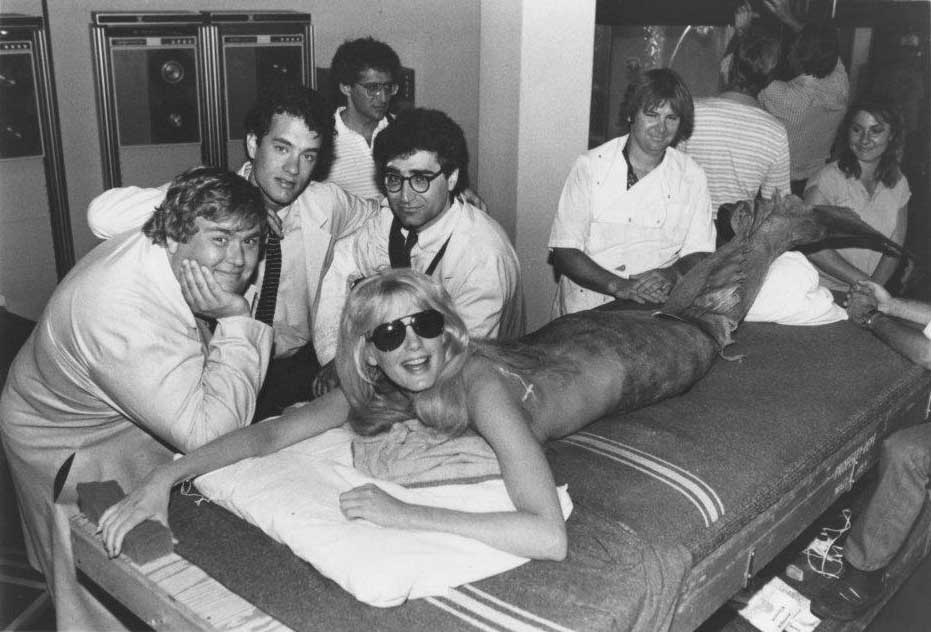
LEGACY
Splash was a huge success from opening day. By the way, no one saw it coming. Hanks told People Magazine, “I didn’t think it would be a stinker, maybe a little cartoonish, but the first weekend I get a call: ‘Six million bucks at the box office.’ You’re in your first big film. It’s beyond my comprehension. That’s a lot of money. You can’t get it much better, right outta the box. It’s perfect.”
Hanks, though, probably did identify why it connected with audiences. He told Entertainment Tonight, “I think everyone was perfectly willing to blow any sort of semblance of reality away when they’re talking about a mermaid. Mermaids are so deeply rooted, as far as folklore is concerned, that they’re almost like Tinkerbell. Okay, alright, we know it doesn’t happen, we know it’s not possible, but c’mon, let’s have a little bit of fun here and just let reality slip, and get into the knowledge that mermaids exist and are as beautiful as Daryl Hannah is, and that they can fall in love with mortals just like us. It’s a nice way to approach going to the movies, the same way as seeing a little extraterrestrial eat the little candies, you know it’s not going to happen, but gosh it’s so neat, let’s just suspend disbelief, it’s only an hour and 40 minutes, there’s plenty of time to deal with the hard edge of reality for the rest of our lives.”
Howard credits Hannah with the movie’s success: "Very few actresses could have done what Daryl Hannah did,” said Ron Howard to Starfix. “She is perfectly at ease in water, and is the key to the magic of Splash.”
Hannah’s character is named Madison. It was a joke in the movie because she’s named after the famous New York City street, Madison Avenue. The character inspired new parents to name their baby girls Madison. By 2001, it was the second most popular girl's name in America. In 2017, Madison was the 17th most popular girl’s name, most people today it came from Splash.
Disney made a sequel in 1988, the made-for-TV movie "Splash, Too."
The Little Mermaid had been in development for a while at Disney Animation, but the success of Splash inspired them to move forward with the animated film. According to IMDb, Ariel was given red hair so that she didn't resemble Madison.
Ron Howard, a beloved child actor, was garnering respect as a director after 1977’s Grand Theft Auto and Night Shift. However, Splash’s box office success helped him get to the next level. He told People he was in the “lunch with Steven” club – meaning, he could now get a lunch meeting with director Steven Spielberg who commanded Hollywood in the 1980s. He also was able to raise his fee, getting $1 million for his next pic, Cocoon.
Hanks predicted great things for Howard, joking to People at the time: “Ron will be huger than all of us, and we’ll really be bitter about it in the future. Ron’s the king.”
Of course, Hanks, Candy and Hannah would all become household names. Hanks’ next movie was Bachelor Party, which he committed to before he knew Splash would be a big hit. He reunited with John Candy just one year later in Volunteers, an unmemorable film except for one important footnote: its where Hanks met his future wife, Rita Wilson.
In Paddington (2014), there’s an homage to Splash. When Allen asks Madison her name, she says it in her language, a dolphin-type pitch that shatters the TV sets. When Mr. Brown asks Paddington his name, he responds with a bear roar.
Denzel Crocker in Nickelodeon animated series "The Fairly Oddparents" is based on Dr. Kornbluth. Crocker also (correctly) believes in a mythological creature, but is treated with skepticism and mockery.
A remake is scheduled for (May 2019) with a gender switch twist: Jillian Bell will play the landlubber and Channing Tatum is a merman! Tom Hanks told the Associated Press that the remake is playing it too safe. “I figure if they were really going to be bold, I would come back as Allen Bauer, and I would go off with Channing Tatum. That would be a bold movie, and I am suggesting it right now!”
Stars of the remake say they’re game for it, too. Jillian Bell, who will play the land-based human, told Us Magazine, "I would personally love if some of the old cast came back. I was a huge fan of it as a kid. I think it was a movie that every kid watched a million times and just totally fell in love with both of those characters and the idea of mermaids being real. That was something that was exciting for us and we thought that could be brought back around today." She added, "My favorite scene is where Daryl eats the lobster."
All kidding aside, Grazer said the gender switch will be powerful: “It actually deals like with the power dynamics in favor of the feminine and by appreciating the feminine dimension.
The original is pretty powerful! Just ask Charlize Theron, who said, "I learned everything about love, watching Splash. That’s why I’m still single, so thanks Tom Hanks and Daryl Hannah for that.”
Soundtrack
The original soundtrack released in 1984 by Cherry Lane Records Ltd. on vinyl and cassette consisted of 14 tracks of the score written by Lee Holdridge and performed by the Royal Philharmonic Orchestra. In 2000, a 26-track version was released by Super Tracks, but only for a promotional purpose - the CD was never offered for sale. Those 26 tracks included all of the music in the film as well as a few interpretations of the songs that were not in the film. Some kind soul did upload it to YouTube and you can listen HERE.
The Super Track compilation includes the film's love/theme song, "Love Came to Me" performed by Rita Coolidge, which was never released as a single.
Director: Ron Howard
Screenwriters: Brian Grazer, Bruce Jay Friedman, Lowell Ganz & Babaloo Mandel
Release Date: March 9., 1984
Rating: PG
Opening Weekend Rank: #1. #2 was likely the rerelease of Pete’s Dragon. Footloose was #3, Against All Odds was #4. Other new releases were Children of the Corn (#8) and The Hotel New Hampshire (#13).
Opening Weekend Box Office: $6.2 million
Lifetime Gross: $69.8 million
Budget: $8 million
Production Company: Touchstone Pictures
Distributor: Buena Vista Pictures

